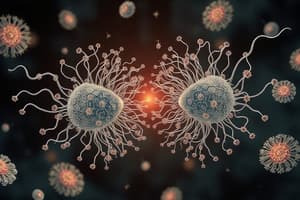Podcast
Questions and Answers
What is the primary role of the conjugation bridge between bacterial cells?
What is the primary role of the conjugation bridge between bacterial cells?
- To protect against viruses
- To facilitate the transfer of genetic material (correct)
- To transfer nutrients
- To provide structural support
All bacteria can undergo the process of transformation.
All bacteria can undergo the process of transformation.
False (B)
What is the term for bacteria that contain the F (fertility) factor?
What is the term for bacteria that contain the F (fertility) factor?
F+ cells
Bacteria can reproduce via _____ fission.
Bacteria can reproduce via _____ fission.
Match the following processes with their descriptions:
Match the following processes with their descriptions:
What phenomenon occurs when a bacterium dies off due to lack of resources?
What phenomenon occurs when a bacterium dies off due to lack of resources?
Viruses can reproduce independently of host cells.
Viruses can reproduce independently of host cells.
Which specific plasmid is best-studied for its role in bacterial conjugation?
Which specific plasmid is best-studied for its role in bacterial conjugation?
During the _____ phase, bacteria adapt to new environmental conditions.
During the _____ phase, bacteria adapt to new environmental conditions.
What is a consequence of patients not completing antibiotic treatments?
What is a consequence of patients not completing antibiotic treatments?
What is the primary method of reproduction for prokaryotic cells?
What is the primary method of reproduction for prokaryotic cells?
Prokaryotic cells can acquire and use genetic material from inside the cell only.
Prokaryotic cells can acquire and use genetic material from inside the cell only.
What are plasmids and why are they important for bacteria?
What are plasmids and why are they important for bacteria?
In binary fission, the circular chromosome _____ to produce two identical daughter cells.
In binary fission, the circular chromosome _____ to produce two identical daughter cells.
Match the following terms with their descriptions:
Match the following terms with their descriptions:
Which of the following is NOT a process of bacterial genetic recombination?
Which of the following is NOT a process of bacterial genetic recombination?
E. coli can replicate every 20 minutes under ideal growth conditions.
E. coli can replicate every 20 minutes under ideal growth conditions.
What is the role of plasmids in bacterial cells?
What is the role of plasmids in bacterial cells?
Bacterial genetic _____ helps increase diversity and promotes evolution.
Bacterial genetic _____ helps increase diversity and promotes evolution.
Which of the following is a benefit of genetic recombination in bacteria?
Which of the following is a benefit of genetic recombination in bacteria?
Flashcards are hidden until you start studying
Study Notes
Prokaryotic vs. Eukaryotic Cells
- Prokaryotic cells differ structurally and biochemically from eukaryotic cells.
- Prokaryotes reproduce asexually through binary fission, a process that is simpler and faster than mitosis.
Binary Fission
- Involves the circular chromosome attaching to the cell wall and replicating during cell growth.
- As the cell enlarges, the plasma membrane and cell wall grow inward, resulting in two identical daughter cells.
- Under ideal growth conditions, some E. coli strains can replicate every 20 minutes.
Genetic Recombination
- Prokaryotic cells typically have a single circular chromosome, with many also containing plasmids—extrachromosomal DNA that provides beneficial traits such as antibiotic resistance.
- Plasmids can carry virulence factors that enhance pathogenicity, including toxin production and traits that evade the immune system.
- Episomes are plasmids that can integrate into the bacterial genome.
Mechanisms of Genetic Recombination
- Bacterial diversity is increased through transformation, conjugation, and transduction.
Transformation
- Involves the uptake of foreign genetic material from lysed neighboring bacteria into the host genome.
- Commonly occurs in gram-negative rods.
Conjugation
- Bacterial mating involves forming a conjugation bridge for unidirectional transfer of genetic material.
- Donor cells (F+) possess the sex factor plasmid; recipient cells (F–) do not.
- The F factor in E. coli is a well-studied example.
- During conjugation, F+ cells replicate and donate F factors, converting F– to F+ and allowing further plasmid transfer.
Transduction
- Unique in requiring a vector (bacteriophage) to transfer DNA from one bacterium to another.
- Bacteriophages may inadvertently include bacterial DNA during assembly, which is then transferred to a new host.
Transposons
- Genetic elements that can move within the genome, possibly disrupting gene function if inserting in coding regions.
Real World Implications
- Incomplete antibiotic courses can lead to increased antibiotic resistance by leaving behind resistant bacteria that proliferate.
- Increased resistance complicates treatment of common infections.
Bacterial Growth Phases
- Bacterial growth follows a series of phases: lag phase (adaptation), exponential/log phase (rapid division), stationary phase (resource depletion slows reproduction), and death phase (resource exhaustion).
- The bacterial growth curve is a semilog plot, indicating the exponential increase during the growth phases.
Bacterial Growth Curve
- A straight line on a semilog plot during the exponential phase reflects a true exponential increase, not a linear one.
Studying That Suits You
Use AI to generate personalized quizzes and flashcards to suit your learning preferences.



